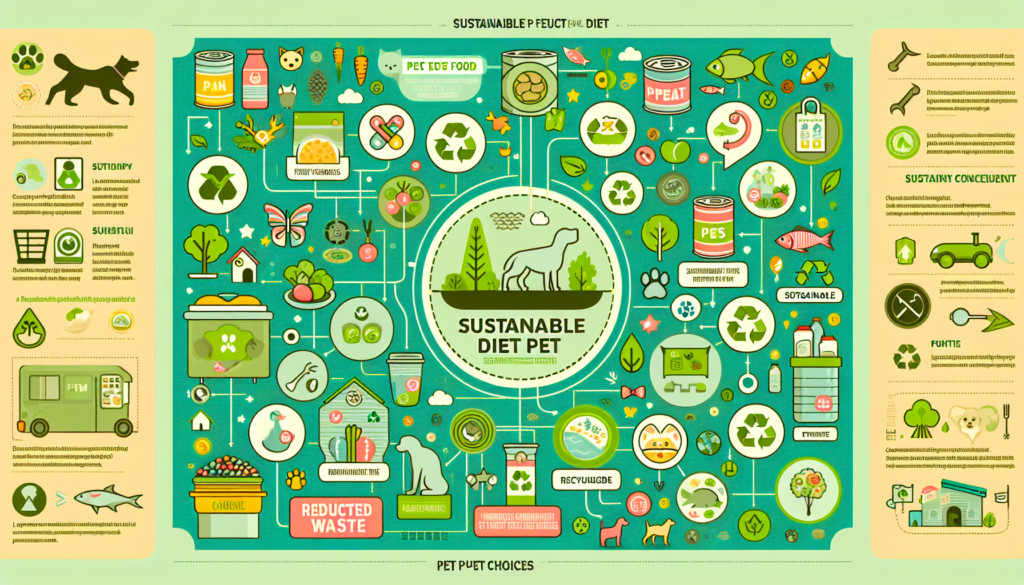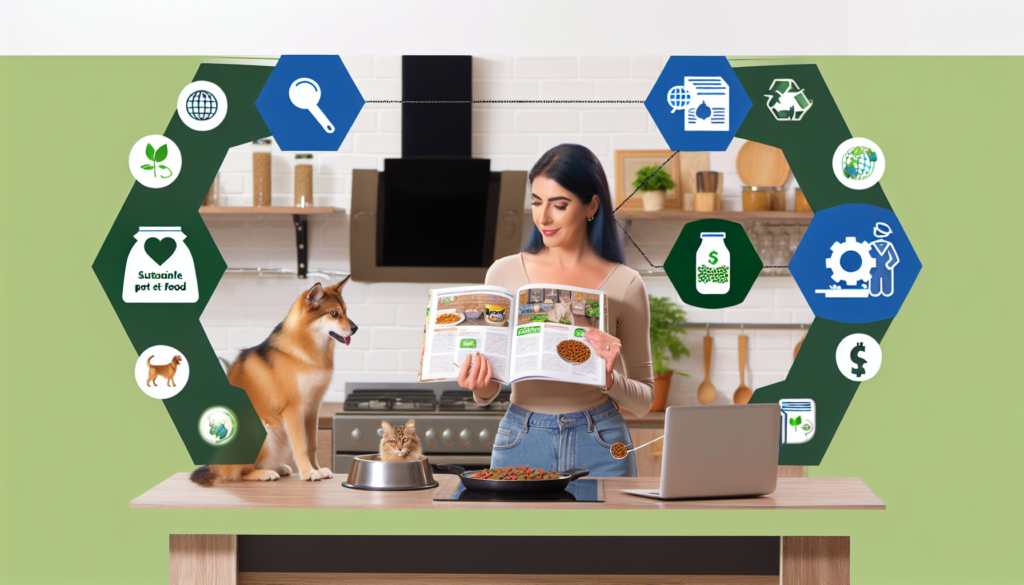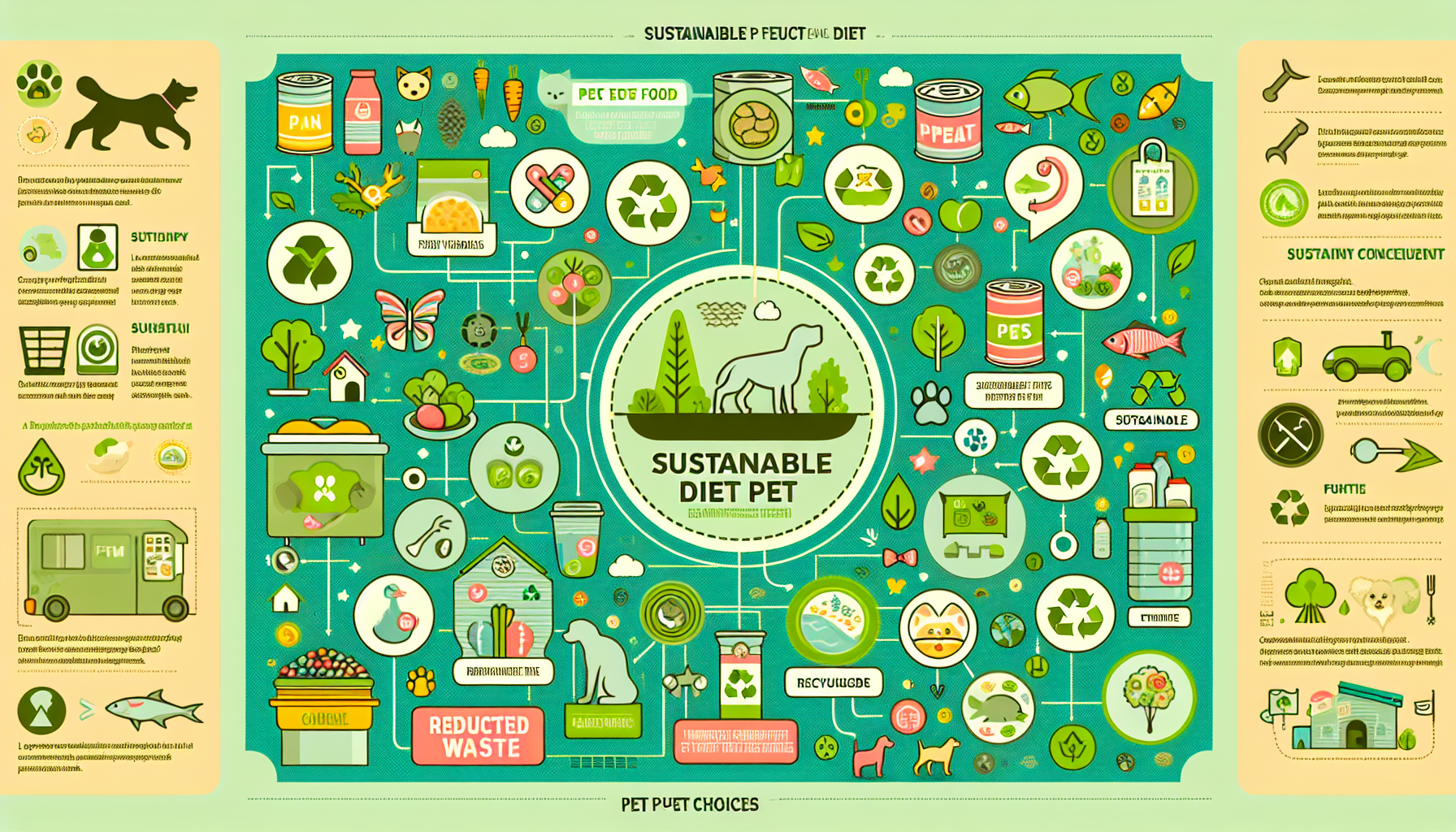Are you concerned about the environmental impact of your pet’s diet? With the rising awareness of sustainable living, many pet owners are seeking ways to reduce their furry friend’s carbon pawprint. In this article, we will guide you on how to plan a sustainable diet for your pets, ensuring they receive the necessary nutrients while being mindful of the planet.

Understanding the Importance of a Sustainable Diet for Pets
Considering the Environmental Impact of Pet Food
When planning your pet’s diet, it’s essential to consider the environmental impact of the food they consume. Traditional pet food production can have a significant carbon footprint, contributing to deforestation, greenhouse gas emissions, and water pollution. By opting for a sustainable diet, you can help minimize these environmental impacts and contribute to a healthier planet for your furry friend.
Promoting Good Health and Longevity
A sustainable diet can also contribute to your pet’s overall health and longevity. Just like humans, pets need a balanced diet to thrive. By choosing high-quality, nutritious ingredients, you can help support their immune system, improve digestion, and promote healthy weight maintenance. A sustainable diet can provide the necessary nutrients to keep your pet energetic, happy, and free from chronic health conditions.
Supporting Ethical and Responsible Pet Ownership
Choosing a sustainable diet for your pet also aligns with ethical and responsible pet ownership. By opting for organic and locally-sourced ingredients, you support local farmers and reduce the reliance on factory farming practices. Additionally, by avoiding harmful additives and artificial preservatives, you prioritize your pet’s well-being while contributing to a more ethical pet food industry.
Factors to Consider When Planning a Sustainable Diet
Assessing Pet’s Nutritional Needs
Before making any changes to your pet’s diet, it’s crucial to assess their specific nutritional needs. Factors such as age, breed, activity level, and any existing health conditions should be taken into consideration. A veterinarian can assist in evaluating your pet’s requirements and recommend the appropriate nutrient ratios and portion sizes for a sustainable diet.
Choosing High-Quality, Organic, and Locally-Sourced Ingredients
To prioritize sustainability in your pet’s diet, opt for high-quality, organic ingredients that are sourced locally whenever possible. Organic ingredients reduce exposure to pesticides and other harmful chemicals, benefiting both your pet’s health and the environment. Locally-sourced ingredients reduce the carbon footprint associated with transportation, supporting local businesses and reducing environmental impact.
Avoiding Harmful Additives and Artificial Preservatives
When selecting pet food, make sure to read the label and avoid products that contain harmful additives and artificial preservatives. These additives can have negative effects on your pet’s health, and they also contribute to environmental pollution during the manufacturing process. Opt for natural preservatives or fresh food options to ensure your pet is receiving a clean and sustainable diet.
Transitioning to a Sustainable Diet
Gradual Transition for Pet’s Digestive System
When transitioning your pet to a new diet, it’s important to do so gradually. Abrupt changes can cause digestive upset, including diarrhea and vomiting. Gradually introduce the new sustainable diet by mixing it with their current food over the course of several weeks. Monitor your pet’s digestion during the transition and make adjustments as needed.
Consulting with a Veterinarian
Before making any significant changes to your pet’s diet, consult with a veterinarian. They can provide guidance specific to your pet’s needs and ensure the transition is smooth and healthy. A veterinarian can also monitor your pet’s weight and overall well-being throughout the transition process, making any necessary adjustments to the diet.
Monitoring Weight and Well-being
During the transition and beyond, it’s crucial to monitor your pet’s weight and overall well-being. Sustainable diets should support a healthy weight, so ensure that your pet is neither underweight nor overweight. Monitor their energy levels, coat condition, and any changes in behavior. Regular veterinary check-ups can help identify and address any issues that may arise.
Balancing Protein, Carbohydrates, and Fats
Determining the Ideal Proportions for Each Nutrient
Properly balancing protein, carbohydrates, and fats is essential for your pet’s healthy diet. The ideal proportions may vary depending on your pet’s species, age, size, and activity level. Consult with a veterinarian to determine the appropriate ratios and portions to provide a sustainable and well-rounded diet for your furry friend.
Considering Pet’s Age, Size, and Activity Level
When determining the proportions of nutrients, it’s crucial to consider your pet’s age, size, and activity level. Puppies and kittens have different nutritional needs than adult or senior pets, and highly active pets may require more protein and carbohydrates. Adjust the portions and ratios accordingly to support your pet’s specific requirements and to maintain their health and energy levels.
Optimizing Digestibility and Nutrient Absorption
To ensure your pet can fully benefit from their sustainable diet, focus on optimizing digestive health and nutrient absorption. Choose high-quality ingredients that are easily digestible and provide high bioavailability of nutrients. Incorporate probiotics or digestive enzymes, if necessary, to support a healthy gut microbiome. Digestive health plays a crucial role in overall well-being, and a sustainable diet can aid in achieving optimal digestive function.

Meeting Essential Nutrient Requirements
Incorporating Essential Amino Acids
Amino acids are the building blocks of proteins and are essential for proper growth and development in pets. When planning a sustainable diet, ensure that your pet receives all the essential amino acids. Animal-based proteins, such as those from meat, eggs, or fish, are complete sources of amino acids, while plant-based proteins may require careful combination to meet all the nutritional requirements.
Providing Adequate Omega-3 Fatty Acids
Omega-3 fatty acids play a vital role in supporting your pet’s immune system, cardiovascular health, and healthy skin and coat. Incorporate fatty fish like salmon or trout into their diet or consider adding algae-based supplements to provide a sustainable source of omega-3 fatty acids. This helps to maintain optimal health and well-being for your furry companion.
Ensuring Sufficient Vitamin and Mineral Intake
A balanced and sustainable diet must also include a sufficient intake of vitamins and minerals. Ensure your pet receives a variety of nutrient-rich ingredients, such as fruits and vegetables, to provide essential vitamins and minerals naturally. If necessary, consult with a veterinarian to determine if additional supplementation is required to meet your pet’s specific needs in a sustainable manner.
Including Plant-Based Foods in Pet’s Diet
Benefits of Plant-Based Ingredients
Incorporating plant-based ingredients into your pet’s diet can provide various benefits. Plant-based ingredients often have a lower carbon footprint compared to animal-based ingredients, making them a more sustainable choice. Additionally, they can provide valuable nutrients, fiber, and antioxidants, contributing to your pet’s overall well-being.
Balancing Plant-Based and Animal-Based Ingredients
When including plant-based ingredients, it’s important to strike a balance with animal-based ingredients to ensure your pet’s nutritional needs are met. While plants can offer valuable nutrients, certain essential nutrients are more readily available from animal-based sources. Consult with a veterinarian to create a balanced and sustainable diet that incorporates both plant-based and animal-based ingredients.
Choosing Safe and Digestible Plant-Based Options
When selecting plant-based ingredients for your pet’s diet, prioritize safety and digestibility. Some plants may be toxic to pets, so it’s crucial to do your research and avoid harmful options. Additionally, consider the digestibility of the chosen plant-based ingredients to ensure your pet can fully benefit from the nutrients. Steam or lightly cook vegetables to enhance digestibility for your pet.
Feeding Schedule and Portion Control
Establishing a Regular Feeding Schedule
Maintaining a regular feeding schedule is crucial for your pet’s health and well-being. Establish a routine that aligns with their natural behavior and energy levels. Regular feeding times can help prevent overeating and support proper digestion. It’s also important to consider the number of meals per day based on your pet’s age and activity level.
Considering the Pet’s Age and Lifestyle
The feeding schedule and portion size should be adapted to your pet’s age and lifestyle. Puppies and kittens may require more frequent meals, while adult or senior pets may benefit from fewer, larger meals. Highly active pets may need more frequent and larger portions to meet their energy requirements. Regularly evaluate and adjust the feeding schedule and portion sizes as needed to maintain a healthy weight and overall well-being.
Avoiding Overfeeding and Obesity
Overfeeding is a common issue that can lead to obesity and associated health problems in pets. By carefully measuring and controlling the portions, you can prevent overeating and maintain a healthy body weight for your pet. Pay attention to their body condition score and consult with a veterinarian if you are unsure about appropriate portion sizes. Treats should also be factored into the overall portion control to avoid excessive calorie intake.
Hydration and Water Quality
Providing Fresh and Clean Water
Just like humans, pets require access to fresh and clean water at all times. Ensure that your pet always has access to a clean water source to stay hydrated and support proper bodily functions. Regularly clean and refill their water bowl to prevent any bacterial growth or contamination.
Choosing Filtered or Purified Water
Water quality can also impact your pet’s health. Consider using filtered or purified water to remove any impurities, such as chlorine, heavy metals, or harmful chemicals. This provides your pet with a cleaner and healthier water source, promoting optimal hydration.
Avoiding Plastic Water Bowls
Avoid using plastic water bowls, as they can contain harmful chemicals that leach into the water over time. Instead, opt for stainless steel or ceramic bowls that are safe, durable, and easy to clean. This helps to minimize potential health risks associated with plastic consumption and contributes to a more sustainable pet care routine.
Supplementation and Treats
Determining Necessary Supplements
Supplementation may be necessary to ensure your pet’s diet is nutritionally balanced. Consult with a veterinarian to determine if any specific supplements are required for your pet’s age, health conditions, or dietary restrictions. Supplements such as multivitamins, joint support, or omega-3 fatty acids can address specific nutritional needs and contribute to a sustainable and healthy diet.
Choosing Healthy and Natural Treat Options
When it comes to treats, choose healthy and natural options that align with your pet’s dietary requirements. Look for treats made from natural ingredients and free from artificial additives or preservatives. You can also consider making homemade treats using nutritious ingredients like lean meats or fruits and vegetables. This allows you to have better control over the quality and sustainability of the treats you offer your pet.
Avoiding Excessive Treat Consumption
While treats can be a great way to show love and provide positive reinforcement, it’s important to avoid excessive treat consumption. Treats should be given in moderation and should not account for a significant portion of your pet’s daily caloric intake. Overindulgence in treats can lead to weight gain and nutritional imbalances. Always consider the nutritional content of treats and adjust the main meal portions accordingly.
Reducing Food Waste
Proper Food Storage and Handling
Reducing food waste is an important aspect of sustainability. Properly storing and handling pet food can help minimize waste and ensure the food remains fresh for your pet’s consumption. Use airtight containers to store dry food and refrigerate or freeze perishable items promptly. Follow the recommended storage instructions provided by the manufacturer to maintain the quality and safety of the food.
Using Leftovers and Homemade Broths
Instead of throwing away leftovers, consider using them to create homemade broths or mix them into your pet’s regular meals. Leftover lean meats, vegetables, and even cooked grains can be added to a broth to create a nutritious and delicious addition to your pet’s diet. Be sure to avoid using any ingredients that may be toxic to pets, such as onions or garlic.
Avoiding Overstocking and Bulk Purchases
To minimize food waste, avoid overstocking or making bulk purchases unless you have a large pet household. Purchase only the amount of food that your pet can consume before it expires. This helps to maintain the freshness of the food and reduces the likelihood of it going to waste. Regularly assess your pet’s food consumption and adjust your purchasing habits accordingly to reduce unnecessary waste.
In conclusion, planning a sustainable diet for your pet is a thoughtful and responsible approach to their well-being. By considering the environmental impact of pet food, promoting good health and longevity, and supporting ethical and responsible pet ownership, you can make a positive impact on both your pet’s life and the planet. Assessing your pet’s nutritional needs, choosing high-quality ingredients, and avoiding harmful additives are key factors to consider when planning a sustainable diet. Transitioning gradually, consulting with a veterinarian, and monitoring weight and well-being are important steps to ensure a smooth transition. Balancing protein, carbohydrates, and fats, meeting essential nutrient requirements, and including plant-based foods in your pet’s diet contribute to their overall health. Establishing a feeding schedule, providing fresh water, and practicing portion control support their daily routine. Choosing healthy treats, reducing food waste, and proper supplementation complete the sustainable diet plan for your beloved pet. With a well-planned sustainable diet, your pet can enjoy a healthy, happy, and environmentally-friendly lifestyle.

